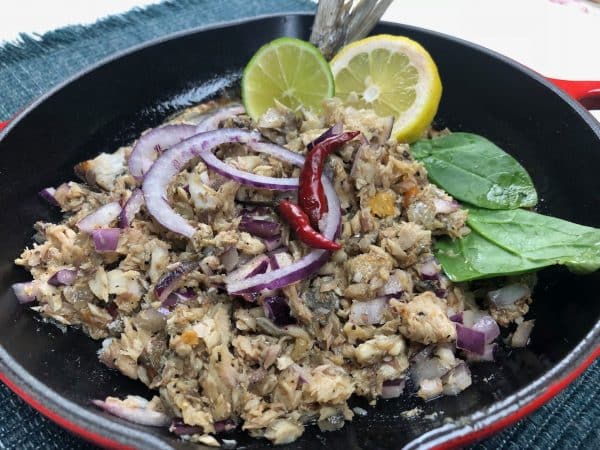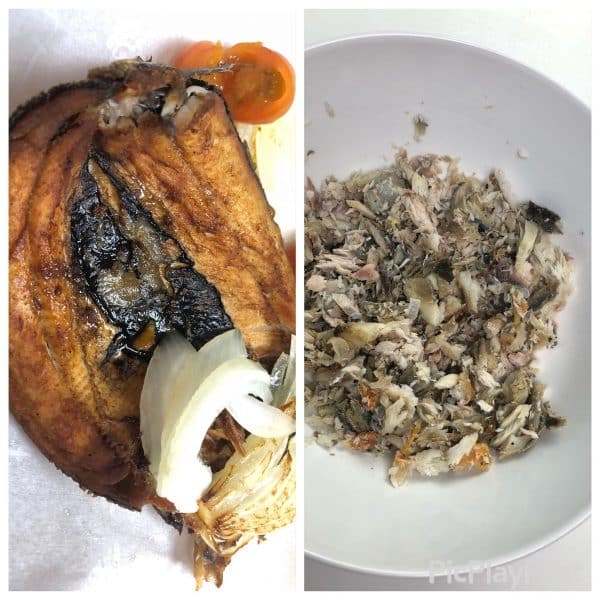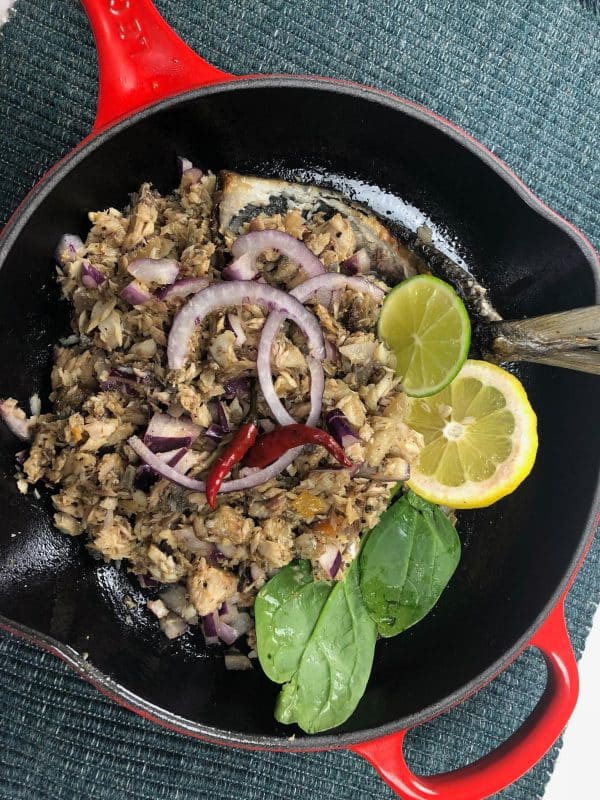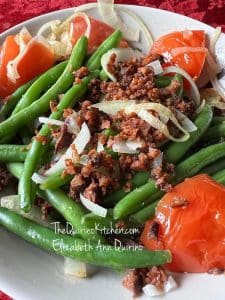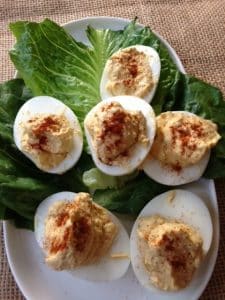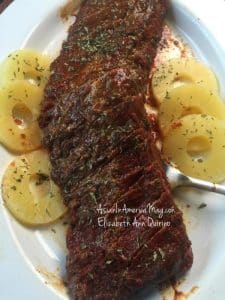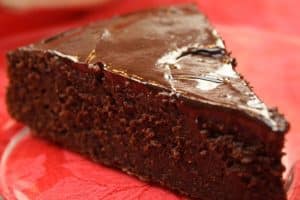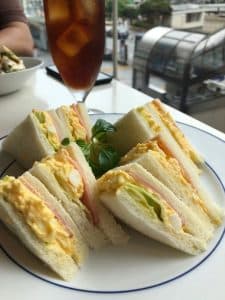Bangus Sisig- Spicy Milkfish Flakes
As an Amazon Associate and member of other affiliate programs, I earn from qualifying purchases.
The Filipino dish Sisig has taken the food scene by storm, not just here in America but in the Philippines and Filipino communities around the world. In addition to the popular pork sisig version, I also make Bangus Sisig, especially if I want a more wholesome approach to our family menu.
Bangus or milkfish was my choice for this appetizer which can also serve as an entrée. The bangus is a white fish variety, that is commonly found in the Philippines. Fishery experts in the Philippines regard the bangus (milkfish) as the backbone of the country’s aquaculture. Commercial production of fish farming like bangus goes back to a century ago. The Philippines is one of the top producers of this fish variety in the world and exports to the United States, the UK, Canada and Japan. Here in America, I buy it at Asian markets – fresh or smoked. If I buy the milkfish fresh, I ask the fish monger to clean the bangus for me, removing the scales, intestines and cutting it up butterfly-style or opened flat. It has a white, meaty flesh that tastes sweet when cooked. Often after the bangus dish is done, the large portion of its fatty belly is the attraction.
To backtrack about sisig, I have known pork sisig as an appetizer since I was a child. At our home in Tarlac years ago, my dad often enjoyed a spicy bowl of sisig as pulutan (appetizer) with his chilled Filipino-brand San Miguel Beer. Sisig has a long history according to Claude Tayag’s book Food Tour: A Culinary Journey. This pork dish started out as a platter of tart, fresh fruits in its unripened stage – like mangoes, guavas and papaya. The dish has evolved through centuries. Pork Sisig goes back to the year 1732 when records in a Pampanga-Spanish dictionary described it, recounts Claude. In the Kulinarya cookbook, pork sisig is defined as “thrice-cooked pork”. Last June, my family and I had fun dining in Angeles City, Pampanga in the Philippines, to eat at Aling Lucing’s, where the original pork sisig was said to have started. The pork sisig at Aling Lucing’s was magnificently spicy, sizzling, savory and the way I remembered it, cooked by Kapampangans.
But back here in my American kitchen, I realized I had cooked too many pieces of pan-fried bangus, butterfly-cut milkfish. A day after freezing the leftover, untouched fillet, I decided to transform it to a sisig dish, bangus version.
Since the fish was already cooked, all I needed to do was flake the fish and remove the bones. This took a few quick minutes. Then I marinated the flakes in condiments that would make the sisig more flavorful, spicier and harder to resist.
After marinating the fish flakes in the refrigerator for a few minutes, it was easy from thereon. The oil and butter sizzled on the cast iron skillet, a signal that the rest of the ingredients were ready to be tossed in. Then a quick sauté of the red onions and garlic prepared the skillet for the addition of the marinated bangus flakes. In seconds, the citrusy aroma of the calamansi (Filipino lime) and the soy sauce filled the air in the kitchen. To me, the citrus flavor and piercing aroma of calamansi or lemon spiked with siling labuyo (chilies) is what defines the sisig. Soon after, I plated the entire fish dish on a sizzling plate, sprinkled a bit more of lemon juice, garnished and served it warm with chilled beer. It was the old classic sisig refurbished in a modern way with a main ingredient that was both familiar and a pleasant surprise. It was sisig without the guilt.
Bangus Sisig- Spicy Milkfish Flakes
Equipment
- Cast-iron large skillet
Ingredients
- 1 pound pan-fried bangus (milkfish), about 2-3 cups de-boned, shredded into flakes
- 1/4 cup calamansi or lemon juice divided, use 2 Tablespoons for marinating cooked bangus
- 1 large red onion chopped, divided, use 1/2 cup to marinate fish
- 4 cloves garlic minced, divided, use 1/2 teaspoon to marinate fish
- 1 Tablespoon soy sauce for marinating fish
- 2 pieces siling labuyo (bird's eye chilies) use 1 chopped, for the fish marinade, the other for garnish
- 1 teaspoon salt
- 1 teaspoon ground black pepper
- 1 teaspoon red pepper flakes
- 2 Tablespoons vegetable oil
- 2 Tablespoons butter
- 1 to 2 stalks scallions or green onions chopped, for garnish
- 2 to 3 slices fresh lemon or calamansi for garnish
Instructions
- In a non-reactive, large bowl, combine the flaked bangus with the marinade ingredients: calamansi juice, red onions, garlic, soy sauce, siling labuyo, red pepper flakes salt and ground black pepper. Mix well. Cover and refrigerate for at least 1 hour till ready to pan-fry.
- In a large, cast-iron skillet, over medium high heat, add the vegetable oil. When oil is hot enough in 1 to 2 minutes, add the butter.
- To the skillet, add the remaining chopped red onions and garlic. Stir fry for 1 to 2 minutes till onions are translucent and garlic is fragrant.
- Add the marinated flaked bangus to the skillet. Carefully mix the ingredients together, making sure the fish does not get mashed.
- Garnish with chopped scallions, additional chopped siling labuyo (chilies) and fresh calamansi or lemon slices. Serve warm as an appetizer, side or entree.
- How to cut the bangus for daing or butterfly-cut – Start the cut at the base of the milkfish. Slip a sharp knife through the back side, slicing through till you reach the edge of the top side. Make sure to cut the fish open all the way to the head. Spread the fish open. Remove entrails with a knife or kitchen shears. Wash the fish with running water. Continue to marinate and cook as recipe indicates.
- Cook's comments to cook a whole bangus: If you don't have cooked bangus, here's how to make it- have the fish monger clean a whole bangus, removing scales, intestines , trimming tail and cutting it "daing" or butterfly-style. Marinate the bangus with 1 tablespoon calamansi or lemon juice, 1 teaspoon each of salt and ground black pepper. Cover and refrigerate for 20 to 30 minutes. In a large, non-stick skillet, over medium-high heat, add 4 tablespoons of vegetable oil. When oil is hot enough in 1 to 2 minutes, pan-fry the whole bangus, for 10 to 12 minutes till completely cooked. Cover while cooking to avoid splatters.
- Hello, Friends! All the images and content on this blog are COPYRIGHT PROTECTED and owned by my media company Besa-Quirino LLC. This means BY LAW you are NOT allowed to copy, scrape, lift, frame, plagiarize or use my photos and recipe content I wrote, on your website,books, films, television shows or videos without my permission. If you want to republish this recipe or content on another website, video, news article,or media outlets mentioned above please ASK my permission, re-write it in your own words and simply link back to this blog to give proper attribution. It’s the legal thing to do. Thank you. Email me at [email protected]
- Disclosure: As a participant in the Amazon Affiliate program, some blog posts contain links to products used in the recipe and sold on Amazon. The price stays the same for the readers who wish to purchase these products on my links. I earn a small commission from Amazon which helps maintain the blog expenses. Thanks in advance for your support.
Nutrition
Notes on Nutrition: The nutrition information provided is an estimate and will vary based on cooking methods and specific brands of ingredients used.
Did you like this recipe?I have more Filipino Instant Pot recipes in my newest cookbook Instant Filipino Recipes: My Mother’s Traditional Philippine Cooking in A Multicooker Pot by Elizabeth Ann Besa-Quirino. I also have more classic recipes inspired by my mother’s cooking in my popular cookbook: My Mother’s Philippine Recipes. If you’re learning how to cook Filipino food or a fan of Philippine cuisine, buy my cookbooks and books on Amazon.com sold worldwide in paperback and Kindle format.
Copyright Notice: Hello, Friends! Please DO NOT LIFT OR PLAGIARIZE my original recipe, stories, photos or videos. All the images and content on this blog are COPYRIGHT PROTECTED and owned by my media company Besa-Quirino LLC. This means BY LAW you are NOT allowed to copy, scrape, lift, frame, plagiarize or use my photos, essays, stories and recipe content on your websites, books, films, television shows, videos, without my permission. If you wish to republish this recipe or content on media outlets mentioned above, please ASK MY PERMISSION, or re-write it in your own words and link back to my blog AsianInAmericaMag.com to give proper attribution. It is the legal thing to do. Thank you. Email me at [email protected]

